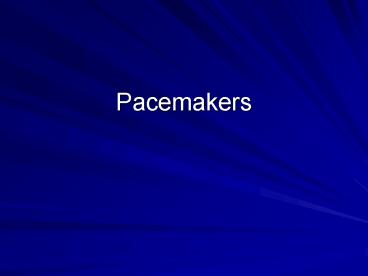Pacemakers - PowerPoint PPT Presentation
Title:
Pacemakers
Description:
Ventricular sensed, ventricular paced Consistent with VVI The Alan E. Lindsay ECG Learning Center ; ... EKG Basics Author: wks07827 Last modified by: Shirley Park – PowerPoint PPT presentation
Number of Views:153
Avg rating:3.0/5.0
Title: Pacemakers
1
Pacemakers
2
Outline
- Pacemaker codes
- Pacemaker configurations
- Indications for pacemakers
- Problems with pacemakers
- Examples
3
Pacemakers
4
Pacemaker Codes
Position Function 1 Chambers Paced 2 Chambers Sensed 3 Response to Sensed Stimulus 4 Rate Modulation?
O (none) O O O (non-rate responsive)
A (atrium) A T (triggered) R (rate responsive)
V (ventricle) V I (inhibited)
D (both atrium ventricle)
5
Pacemaker ConfigurationsVOO
Indications Temporary mode some-times used during
surgery to prevent interference from
electrocautery
6
Pacemaker ConfigurationsVVI
Indications The combination of AV block and
chronic atrial arrhythmias (particularly atrial
fibrillation).
7
Pacemaker ConfigurationsAAI
Indications Sick sinus syndrome in the absence of
AV node disease or atrial fibrillation.
8
Pacemaker ConfigurationsVDD
Indications AV block with intact sinus node
function (particularly useful in congenital AV
block).
9
Pacemaker ConfigurationsDDD
Indications 1. The combination of AV block and
SSS. 2. Patients with LV dysfunction and LV
hypertrophy who need coordination of atrial and
ventricular contractions to maintain adequate CO.
10
Indications for Pacemaker
- Class I
- 1. Sinus node dysfunction with documented
symptomatic bradycardia - 2. Symptomatic chronotropic incompetence (failure
to increase HR with exercise or increased
metabolic demand) - 3. 3 and advanced 2 AV block associated with
any of the following - Arrhythmias that require drugs resulting in
symptomatic bradycardia - Sinus pauses gt 3 seconds
- Asymptomatic escape rate lt 40bpm while awake
- 4. 3 or 2 AV block with associated symptomatic
bradycardia - 5. Type II 2 AV block with wide QRS, regardless
of symptoms
11
Indications for Pacemaker
- Class IIa
- 1. Syncope of unexplained origin when major
abnormalities of sinus node function are
discovered or provoked during EP studies. - 2. Asymptomatic 3 AV block with an awake
ventricular rate gt 40bpm - 3. Asymptomatic type II 2 AV block
12
Problems with PacemakersFailure to Capture
Braunwald's Heart Disease A Textbook of
Cardiovascular Medicine, 7th ed., 2005.
Causes
- Threshold rise (electrolytes, drugs)
- Lead dislodgement
- Lead fracture
- RV infarct
13
Problems with PacemakersFailure to Pace
Braunwald's Heart Disease A Textbook of
Cardiovascular Medicine, 7th ed., 2005.
Causes
- Oversensing
- Battery failure
- Internal insulation failure
- Conductor coil fracture
14
Problems with PacemakersFailure to Pace
Braunwald's Heart Disease A Textbook of
Cardiovascular Medicine, 7th ed., 2005.
Causes
- Crosstalk
15
Problems with PacemakersFailure to Sense
Braunwald's Heart Disease A Textbook of
Cardiovascular Medicine, 7th ed., 2005.
Causes
- Undersensing
- Lead Fracture
16
Example 1
The Alan E. Lindsay ECG Learning Center
http//medstat.med.utah.edu/kw/ecg/
Ventricular sensed, ventricular paced Consistent
with VVI
17
Example 2
The Alan E. Lindsay ECG Learning Center
http//medstat.med.utah.edu/kw/ecg/
Atrial sensed, ventricular paced Consistent with
DDD or VDD
18
Example 3
The Alan E. Lindsay ECG Learning Center
http//medstat.med.utah.edu/kw/ecg/
Atrial paced Consistent with AAI or DDD
19
Example 4
The Alan E. Lindsay ECG Learning Center
http//medstat.med.utah.edu/kw/ecg/
Failure to Pace
20
Example 5
The Alan E. Lindsay ECG Learning Center
http//medstat.med.utah.edu/kw/ecg/
Failure to Sense































